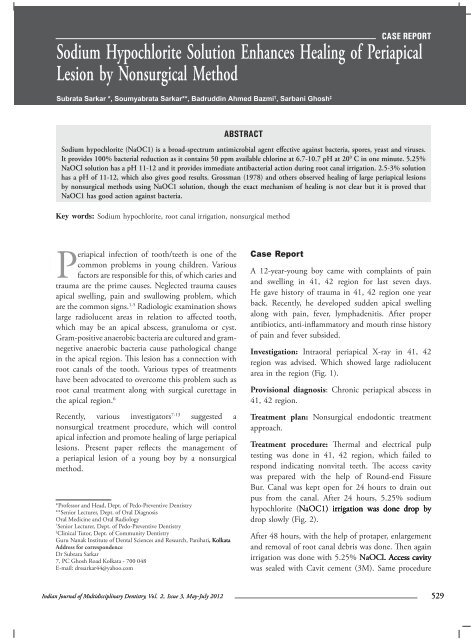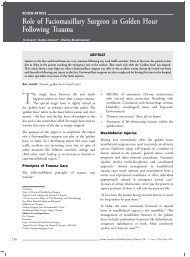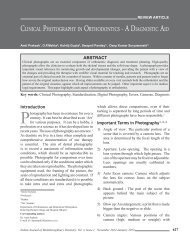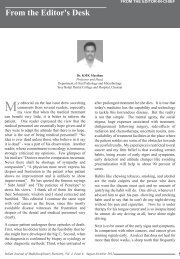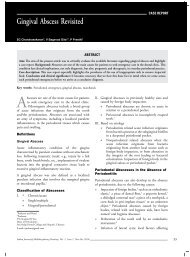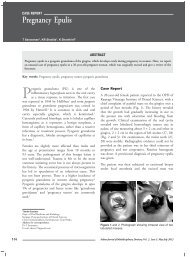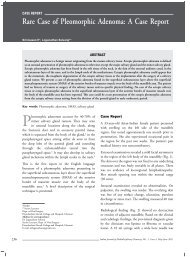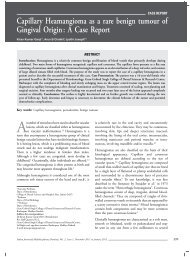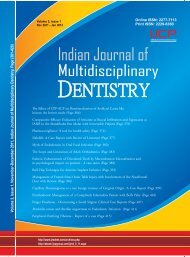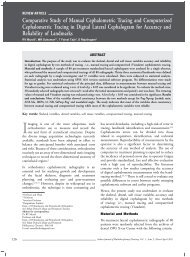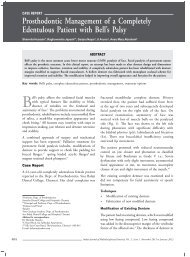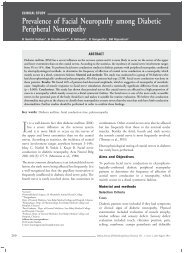Volume 2 - Issue 3 (May-Jul)
Volume 2 - Issue 3 (May-Jul)
Volume 2 - Issue 3 (May-Jul)
Create successful ePaper yourself
Turn your PDF publications into a flip-book with our unique Google optimized e-Paper software.
Sodium Hypochlorite Solution Enhances Healing of Periapical<br />
Lesion by Nonsurgical Method<br />
Subrata Sarkar *, Soumyabrata Sarkar**, Badruddin Ahmed Bazmi † , Sarbani Ghosh ‡<br />
case report<br />
Abstract<br />
Sodium hypochlorite (NaOC1) is a broad-spectrum antimicrobial agent effective against bacteria, spores, yeast and viruses.<br />
It provides 100% bacterial reduction as it contains 50 ppm available chlorine at 6.7-10.7 pH at 20 0 C in one minute. 5.25%<br />
NaOCl solution has a pH 11-12 and it provides immediate antibacterial action during root canal irrigation. 2.5-3% solution<br />
has a pH of 11-12, which also gives good results. Grossman (1978) and others observed healing of large periapical lesions<br />
by nonsurgical methods using NaOC1 solution, though the exact mechanism of healing is not clear but it is proved that<br />
NaOC1 has good action against bacteria.<br />
Key words: Sodium hypochlorite, root canal irrigation, nonsurgical method<br />
Periapical infection of tooth/teeth is one of the<br />
common problems in young children. Various<br />
factors are responsible for this, of which caries and<br />
trauma are the prime causes. Neglected trauma causes<br />
apical swelling, pain and swallowing problem, which<br />
are the common signs. 1-5 Radiologic examination shows<br />
large radiolucent areas in relation to affected tooth,<br />
which may be an apical abscess, granuloma or cyst.<br />
Gram-positive anaerobic bacteria are cultured and gramnegetive<br />
anaerobic bacteria cause pathological change<br />
in the apical region. This lesion has a connection with<br />
root canals of the tooth. Various types of treatments<br />
have been advocated to overcome this problem such as<br />
root canal treatment along with surgical curettage in<br />
the apical region. 6<br />
Recently, various investigators 7-13 suggested a<br />
nonsurgical treatment procedure, which will control<br />
apical infection and promote healing of large periapical<br />
lesions. Present paper reflects the management of<br />
a periapical lesion of a young boy by a nonsurgical<br />
method.<br />
*Professor and Head, Dept. of Pedo-Preventive Dentistry<br />
**Senior Lecturer, Dept. of Oral Diagnosis<br />
Oral Medicine and Oral Radiology<br />
†<br />
Senior Lecturer, Dept. of Pedo-Preventive Dentistry<br />
‡<br />
Clinical Tutor, Dept. of Community Dentistry<br />
Guru Nanak Institute of Dental Sciences and Research, Panihati, Kolkata<br />
Address for correspondence<br />
Dr Subrata Sarkar<br />
7, PC Ghosh Road Kolkata - 700 048<br />
E-mail: drssarkar44@yahoo.com<br />
Case Report<br />
A 12-year-young boy came with complaints of pain<br />
and swelling in 41, 42 region for last seven days.<br />
He gave history of trauma in 41, 42 region one year<br />
back. Recently, he developed sudden apical swelling<br />
along with pain, fever, lymphadenitis. After proper<br />
antibiotics, anti-inflammatory and mouth rinse history<br />
of pain and fever subsided.<br />
Investigation: Intraoral periapical X-ray in 41, 42<br />
region was advised. Which showed large radiolucent<br />
area in the region (Fig. 1).<br />
Provisional diagnosis: Chronic periapical abscess in<br />
41, 42 region.<br />
Treatment plan: Nonsurgical endodontic treatment<br />
approach.<br />
Treatment procedure: Thermal and electrical pulp<br />
testing was done in 41, 42 region, which failed to<br />
respond indicating nonvital teeth. The access cavity<br />
was prepared with the help of Round-end Fissure<br />
Bur. Canal was kept open for 24 hours to drain out<br />
pus from the canal. After 24 hours, 5.25% sodium<br />
hypochlorite (NaOC1) irrigation was done drop by<br />
drop slowly (Fig. 2).<br />
After 48 hours, with the help of protaper, enlargement<br />
and removal of root canal debris was done. Then again<br />
irrigation was done with 5.25% NaOCl. Access cavity<br />
was sealed with Cavit cement (3M). Same procedure<br />
Indian Journal of Multidisciplinary Dentistry, Vol. 2, <strong>Issue</strong> 3, <strong>May</strong>-<strong>Jul</strong>y 2012<br />
529


